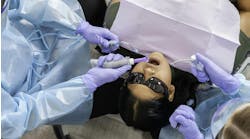Louis Malcmacher, DDS
Using 37 percent phosphoric acid etch on teeth for bonding and adhesive procedures has been the norm since the 1950s. We know that etching teeth creates micro-mechanical retention in the enamel and dentin, which is the entire basis for how composite resins stick to teeth. Today, the addition of many self-etching bonding agents puts us on the tip of the horizon of a new era in dentistry.
Interestingly, when I began practice more than 20 years ago, we were advised to etch teeth for a minimum of 60 seconds and never to etch the dentin. Over the years, the time for etching teeth has come down considerably to a comfortable 10 to 15 seconds, with the total-etch technique of enamel and dentin becoming the norm. Now we are at a new phase of eliminating the etching step completely with self-etching bonding agents.
All of the self-etching bonding agents are very acidic. Because of their low pH, you are, in fact, etching teeth with these bonding agents. The only difference is that this is now a one-step process of etch, prime, and bond, whereas in the past it was a multistep process.
Using acidic materials on teeth is really not a new concept. Zinc phosphate cement, which was the standard in dentistry for many years to cement permanent restorations, did etch teeth because of the phosphoric acid in the cement.
Using self-etching bonding agents is indeed a leap of faith. It's hard to eliminate a step that is so ingrained in our bonding process, and then believe that the procedure will actually work without etching. Actually, it does work quite well, so if you haven't tried these agents, the time is now.
The self-etching bonding agents are applied to a clean, dry tooth surface and gently agitated and rubbed into the tooth surface for about 15 seconds. They are then briefly air-thinned. Then, depending on the self-etching adhesive, they are either cured with a light or just left alone. Some of the self-etching adhesives are a two-bottle system, beginning with a drop from one bottle to the tooth, followed by a drop from the second bottle. Some of the two-bottle systems are mixed together before application to the tooth surface.
When introducing any new material or technique, it is best to try it on a few select cases first and see how it works in your hands. I recommend trying a few cases on small Class I's or IIs. It is important to know that self-etching bonding agents work best on dentin and cut enamel. I now use it routinely in all types of restorative applications.
One big advantage of self-etching adhesives is that they produce less sensitivity because of the elimination of the etching step. They are easy and faster to use, and are competitively priced. One note of caution — not all self-etching bonding agents work with self-cure or dual-cured composite resins. Find out what your chosen bonding agent is compatible with. Some examples of self-etching bonding agents on the market are Tenure Uni-Bond, Simplicity, Xeno, Prompt-L-Pop, FL-Bond, One-Up Bond F, AdheSE, Optibond Solo Plus, Clearfil SE Bond, and I Bond.
It is wonderful to see advancements in adhesive dentistry, and self-etching bonding agents are a major advancement. Now, how about a dental restorative that bonds itself to teeth, releases fluoride, has no sensitivity, wears like enamel, and looks great? Well, we can dream, but I'm sure that will be in our future!
Dr. Louis Malcmacher is an international lecturer and author known for hiscomprehensive and entertaining style.An evaluator for Clinical Research Associates, Dr. Malcmacher is a consultant to the Council on Dental Practice of the ADA. For close to two decades, Dr. Malcmacher has inspired his audiences to truly enjoy practicing dentistry by providing the knowledge necessary for excellent clinical and practice-management skills. His group dental practice has maintained a 45 percent overhead since 1988.For details about his speaking schedule, Dr. Malcmacher can be reached at (440) 892-1810 or via email at [email protected].




